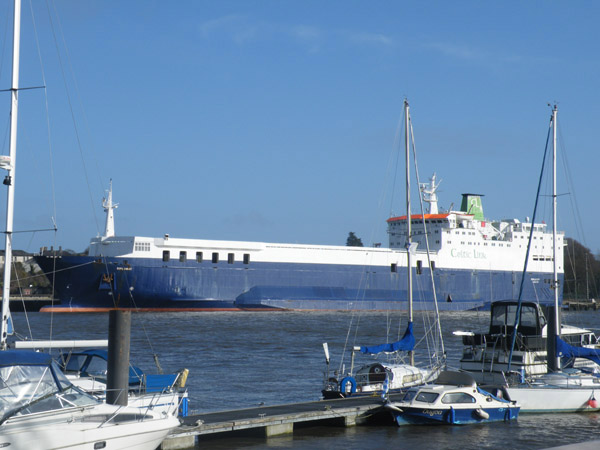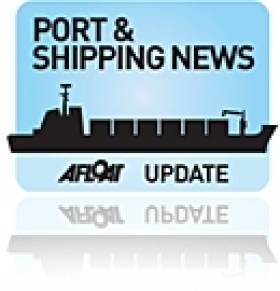Displaying items by tag: Finnforest
Celtic Charter Finnforest to Italians
The Finnforest has since 1999 served several Scandinavian routes. In 2008 Celtic Link Ferries purchased the Finnforest and continued chartering arrangements with Finnlines on the Helsinki-Gdynia route in the Baltic Sea. The charter ceased earlier this year with the vessel returning to Dublin for dry-docking in July. The Finnforest then proceeded into lay-up in Waterford. On the 30 September the Finnforest departed Waterford's city-centre quays bound for the Mediterranean Sea.
Also joining Finnforest on the Naples-Palermo route are the passenger cruise ferries SNAV Snav Lazio and Snav Sardegna which were transferred in early October from another route of SNAV (Societa Navigazione Alta Velocita) extensive ferry network of services from Italy to Corsica, Sardinia, Croatia and Sicily.
The cruise ferries vessels had previously served on P&O Ferries English Channnel route as sisters Pride of Portsmouth and Pride of Le Havre. Launched for Olau Line, the German built twins replace the SNAV Campania and SNAV Sicilia, former North Sea Ferries (later P&O Ferries) sisters Norland and Norstar. The sisters were withdrawn from the Naples-Palermo service and are reported to have sailed for Jeddah. It is uncertain if the 1973 built pair will see further service in the Red Sea or are heading further east.
The Finnforest was built in South Korea as one of the successful 'Searunner' class of vessels ordered by Stena Rederi during the 1970's. Finnforest's half-sister Diplomat (1978/16,776grt) is on charter too by the Wexford based company. The Diplomat had operated Celtic Link Ferries Rosslare-Cherbourg route until late 2009 before also going to lay-up at Waterford. In April, the Diplomat was chartered to Marine Express to operate in the Caribbean on routes between Peurto Rico and the Dominican Republican.
In 2008 Louis Dreyfus Armateurs ferry subsidiary LD Lines chartered the new 26,500 grt ro-pax Norman Voyager from Liverpool based Meridian Marine Management for the Portsmouth-Le Havre route. In addition a Le Havre-Rosslare round-trip was scheduled at the weekends. LD Lines then switched the French port to neighbouring Cherbourg. The service to Ireland was short-lived with the French company abandoning the route. Subsequently the Norman Voyager was was sub-chartered by LD Lines to Celtic Link Ferries. The 800 passenger / 200 vehicle /120 truck ro-pax currently operates three sailings per week in each direction.Celtic's Caribbean Connection
The O'Flaherty Brothers of Wexford have a diverse range of shipping interests ranging from a fishing trawler fleet, a short-sea coaster and ferries under the Celtic Link Ferries banner, writes Jehan Ashmore.
The shipping family can now also claim to have operations in the far-flung seas of the Caribbean Sea through the chartering of their freight-ferry Diplomat (1978/16,776grt) which was replaced late last year by Norman Voyager (2008/26,500grt) on the Rosslare-Cherbourg route.

Celtic Link Ferries former French freight-ferry, Diplomat laid-up at Waterford earlier this year is now serving in the Caribbean Sea. Photo: Jehan Ashmore/ShipSNAPS
Diplomat spent the winter laid-up at Waterford, where the 32-year vessel was one of the largest vessels to dock at the city-centre quays and formed a temporary albeit floating landmark.
In April the veteran departed Irish shores to take up a new career in the Caribbean. The Diplomat now serves three weekly round trips for Marine Express between the ports of Mayaguez and the capital of San Juan in Peurto Rico and Rio Haina and San Domingo, the capital in the Dominican Republic, which shares the large island of Hispaniola with Haiti.
In an earlier career, the Diplomat whilst serving as the Baltic Ferry, was requistioned by the British Military of Defence as part of the Falkland Islands task force in the war with Argentina in 1982. The vessel saw action which involved Royal Air Force Harrier Jump-Jets landing on the cargo-deck using the aircraft's unique vertical take-off lift (VTOL) capability.
Another vessel under the O'Flaherty sphere of operations, Finnforest (1978/15,525grt), a sistership of Diplomat and built from a series of successful Searunner-class vessels ordered by Stena Rederi, returned to Dublin early this year. The vessel had spent several years on charter to Finnlines serving in the Baltic Sea between Helsinki and Gdynia, Poland.
Finnforest like the Diplomat underwent dry-docking at Dublin, with both vessels heading afterwards for lay-up periods at Waterford. Finnforest remains laid-up awaiting a charter while berthed alongside the city-centre's disused quays on the Co. Kilkenny side of the River Suir.






























































